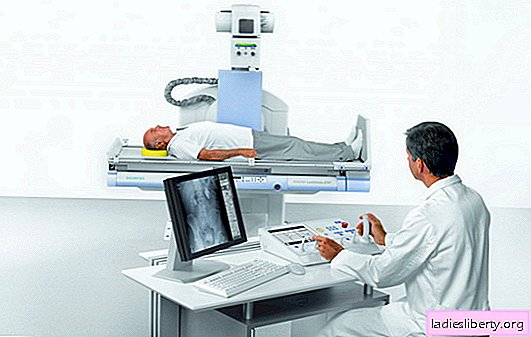
How often can an X-ray be given to a person to avoid unwanted health problems?
It is well known that you can not do x-rays more often than once a year, this is true, but not for all groups of people, so the answer to the question will be purely individual and depends primarily on the appointment of the doctor and the patient’s health.
Let's determine how many times a year is allowed to do x-rays for different groups of people.
How many times a year you can take an x-ray (adult, child): we determine the risks
Radiation actually carries a great danger, but only in those cases when its dose in total will exceed its allowable threshold. For example, in the Russian Federation this level is defined in the Federal Law "On the Radiation Safety of the Population." This law states that the allowable dose for an adult and relatively healthy person should not exceed the allowable norm, which is 1 millisievert (1 mSv).
The law specifies medical exposure, which differs significantly from the background of the planet, for example, in that it is ionizing. A distinctive feature of the beam is that it is eliminated 5 minutes after exposure by an x-ray tube.
How to correctly calculate how often radiography is allowed? This issue can become especially acute in cases when several doctors need to enlighten the chest at once, regardless of each other (for example, to a surgeon, cardiologist and pulmonologist?). It is impossible to unequivocally answer this question, since each specific case may vary, everything will depend on the general condition of the patient, the nature and stage of the disease, as well as the features of the radiological equipment.
Determine the permissible frequency of radiography for different groups of people:
for a relatively healthy person for preventive purposes, x-rays should be carried out no more than 1 time per year. The year will be considered from the moment of the last x-ray examination;
persons not included in any risk group (harmful enterprise, smoking, improper lifestyle, and so on) can be irradiated no more than 1-2 times a year;
people who work directly with children or in the food industry need to do x-ray lighting every 6 months;
if the patient is seriously ill, for example, with a complex form of pneumonia, in this case the procedure can be done very often, up to 2-3 times a week. Despite the harmfulness of such frequent exposures, this is a necessary measure to assess the condition of the patient, as well as the dynamics and productivity of the treatment course. In any case, the risk of harm from developing pneumonia (or another disease) and radiation from x-ray equipment are simply not comparable.
In addition, if we are talking about modern x-ray devices, then they significantly exceed the previous models, outdated with time, in terms of their characteristics. This means that the harm from their radiation will be many times lower.
Before the start of the examination, the patient can be asked the radiologist several clarifying questions. He also has every right to demand an indication of the date of the X-ray procedures and the magnitude of the level of exposure obtained.
So, we estimate the frequency of an acceptable X-ray examination:
1) the purpose of the appointment is medical or diagnostic;
2) the level of patient exposure during the last procedure (determination of his individual radiation passport);
3) assessment of the benefits and harms of the study.
How many times a year you can do radiography
As for children under 18 years of age who have a suspicion of lung disease, they are allowed to take an X-ray, but they are not allowed to do fluorography, as this may affect their health in the future.
Some doctors believe that a diagnostic x-ray should be done to the patient as many times as the situation requires when pathological abnormalities are detected. However, this judgment cannot be called rational, since most diseases of the chest can be determined by safer methods, such as:
listening;
Ultrasound
blood test from a vein or finger.
Such a judgment can be considered rational only if there is a suspicion of a serious stage of pneumonia or lung cancer and if there is no positive trend in the treatment of the disease.
X-rays give a certain radiation dose to the human body. If possible, then frequent exposure, of course, is better to avoid, but there are situations when there is an urgent need. In addition, there is always the danger of a "natural background" of radiation from a polluted environment, which is especially applicable to any large industrial cities.
Modern x-ray machines have a great advantage over standard conventional equipment, as they can minimize the dose of radiation ions that affect the patient. The radiation load becomes point, since only the selected area is exposed to research.
How many times a year you can do radiography: radiation prevention
The consequences of irradiation are very different, from imperceptible to terrifying, for example, the development of cancer. However, one does not need to worry much about it - the likelihood of malignant tumors is very low, but it’s better to beware once again.
To do this, follow a few simple rules:
before the procedure and after it is recommended to strengthen the body with antioxidants;
eat more vitamins of groups A, C, E, this will help increase immunity;
add to your diet more than all kinds of dairy products: milk, sour cream, cottage cheese and so on;
oatmeal, prunes, granular bread will help get rid of harmful substances.
Thus, a healthy person is not recommended to take an X-ray of the lungs more than once, in rare cases - 2 times a year. The total dose should not be higher than 1 mSv.











